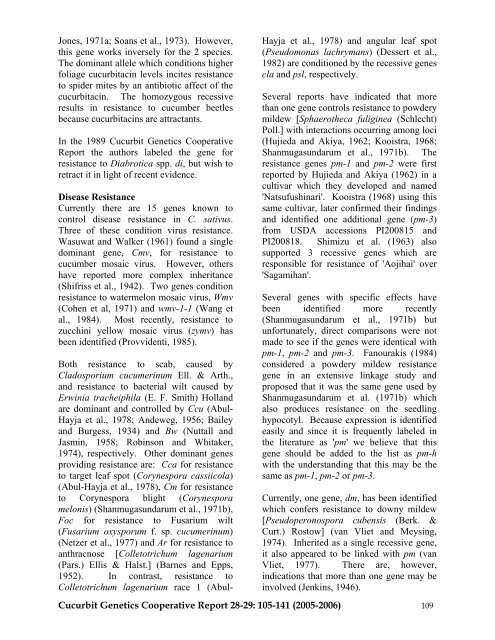Complete volume with articles 1 to 32 - Cucurbit Breeding - North ...
Complete volume with articles 1 to 32 - Cucurbit Breeding - North ...
Complete volume with articles 1 to 32 - Cucurbit Breeding - North ...
You also want an ePaper? Increase the reach of your titles
YUMPU automatically turns print PDFs into web optimized ePapers that Google loves.
Jones, 1971a; Soans et al., 1973). However,<br />
this gene works inversely for the 2 species.<br />
The dominant allele which conditions higher<br />
foliage cucurbitacin levels incites resistance<br />
<strong>to</strong> spider mites by an antibiotic affect of the<br />
cucurbitacin. The homozygous recessive<br />
results in resistance <strong>to</strong> cucumber beetles<br />
because cucurbitacins are attractants.<br />
In the 1989 <strong>Cucurbit</strong> Genetics Cooperative<br />
Report the authors labeled the gene for<br />
resistance <strong>to</strong> Diabrotica spp. di, but wish <strong>to</strong><br />
retract it in light of recent evidence.<br />
Disease Resistance<br />
Currently there are 15 genes known <strong>to</strong><br />
control disease resistance in C. sativus.<br />
Three of these condition virus resistance.<br />
Wasuwat and Walker (1961) found a single<br />
dominant gene, Cmv, for resistance <strong>to</strong><br />
cucumber mosaic virus. However, others<br />
have reported more complex inheritance<br />
(Shifriss et al., 1942). Two genes condition<br />
resistance <strong>to</strong> watermelon mosaic virus, Wmv<br />
(Cohen et al, 1971) and wmv-1-1 (Wang et<br />
al., 1984). Most recently, resistance <strong>to</strong><br />
zucchini yellow mosaic virus (zymv) has<br />
been identified (Provvidenti, 1985).<br />
Both resistance <strong>to</strong> scab, caused by<br />
Cladosporium cucumerinum Ell. & Arth.,<br />
and resistance <strong>to</strong> bacterial wilt caused by<br />
Erwinia tracheiphila (E. F. Smith) Holland<br />
are dominant and controlled by Ccu (Abul-<br />
Hayja et al., 1978; Andeweg, 1956; Bailey<br />
and Burgess, 1934) and Bw (Nuttall and<br />
Jasmin, 1958; Robinson and Whitaker,<br />
1974), respectively. Other dominant genes<br />
providing resistance are: Cca for resistance<br />
<strong>to</strong> target leaf spot (Corynespora cassiicola)<br />
(Abul-Hayja et al., 1978), Cm for resistance<br />
<strong>to</strong> Corynespora blight (Corynespora<br />
melonis) (Shanmugasundarum et al., 1971b),<br />
Foc for resistance <strong>to</strong> Fusarium wilt<br />
(Fusarium oxysporum f. sp. cucumerinum)<br />
(Netzer et al., 1977) and Ar for resistance <strong>to</strong><br />
anthracnose [Colle<strong>to</strong>trichum lagenarium<br />
(Pars.) Ellis & Halst.] (Barnes and Epps,<br />
1952). In contrast, resistance <strong>to</strong><br />
Colle<strong>to</strong>trichum lagenarium race 1 (Abul-<br />
Hayja et al., 1978) and angular leaf spot<br />
(Pseudomonas lachrymans) (Dessert et al.,<br />
1982) are conditioned by the recessive genes<br />
cla and psl, respectively.<br />
Several reports have indicated that more<br />
than one gene controls resistance <strong>to</strong> powdery<br />
mildew [Sphaerotheca fuliginea (Schlecht)<br />
Poll.] <strong>with</strong> interactions occurring among loci<br />
(Hujieda and Akiya, 1962; Kooistra, 1968;<br />
Shanmugasundarum et al., 1971b). The<br />
resistance genes pm-1 and pm-2 were first<br />
reported by Hujieda and Akiya (1962) in a<br />
cultivar which they developed and named<br />
'Natsufushinari'. Kooistra (1968) using this<br />
same cultivar, later confirmed their findings<br />
and identified one additional gene (pm-3)<br />
from USDA accessions PI200815 and<br />
PI200818. Shimizu et al. (1963) also<br />
supported 3 recessive genes which are<br />
responsible for resistance of 'Aojihai' over<br />
'Sagamihan'.<br />
Several genes <strong>with</strong> specific effects have<br />
been identified more recently<br />
(Shanmugasundarum et al., 1971b) but<br />
unfortunately, direct comparisons were not<br />
made <strong>to</strong> see if the genes were identical <strong>with</strong><br />
pm-1, pm-2 and pm-3. Fanourakis (1984)<br />
considered a powdery mildew resistance<br />
gene in an extensive linkage study and<br />
proposed that it was the same gene used by<br />
Shanmugasundarum et al. (1971b) which<br />
also produces resistance on the seedling<br />
hypocotyl. Because expression is identified<br />
easily and since it is frequently labeled in<br />
the literature as 'pm' we believe that this<br />
gene should be added <strong>to</strong> the list as pm-h<br />
<strong>with</strong> the understanding that this may be the<br />
same as pm-1, pm-2 or pm-3.<br />
Currently, one gene, dm, has been identified<br />
which confers resistance <strong>to</strong> downy mildew<br />
[Pseudoperonospora cubensis (Berk. &<br />
Curt.) Ros<strong>to</strong>w] (van Vliet and Meysing,<br />
1974). Inherited as a single recessive gene,<br />
it also appeared <strong>to</strong> be linked <strong>with</strong> pm (van<br />
Vliet, 1977). There are, however,<br />
indications that more than one gene may be<br />
involved (Jenkins, 1946).<br />
<strong>Cucurbit</strong> Genetics Cooperative Report 28-29: 105-141 (2005-2006) 109
















